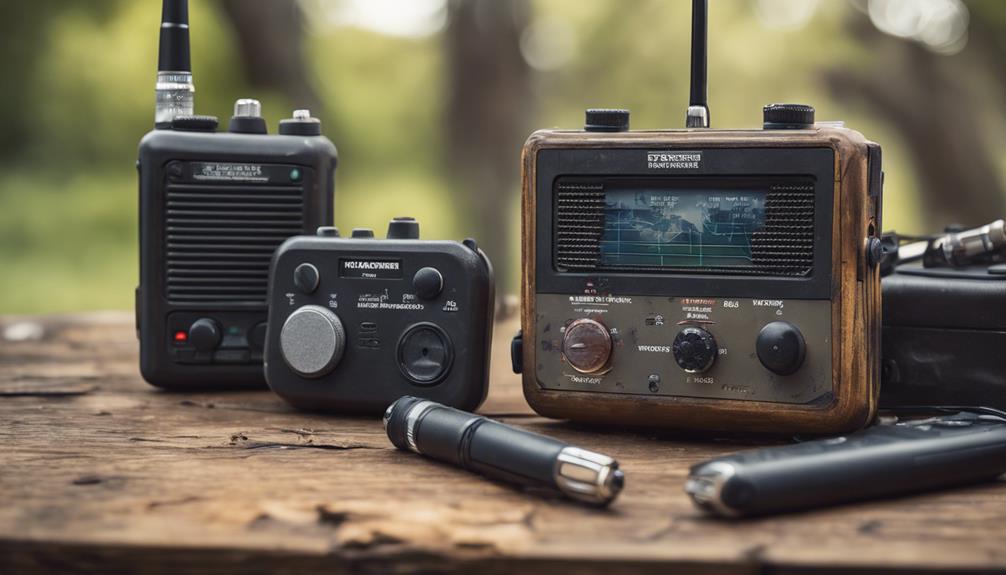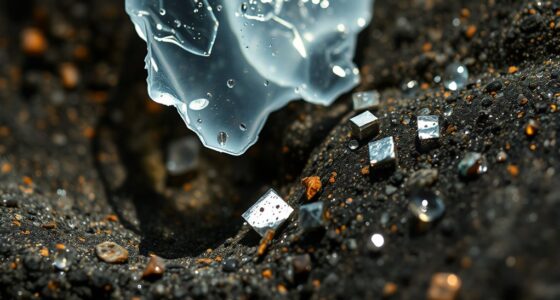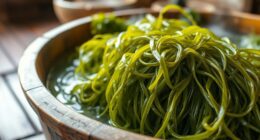When foraging periwinkles, start by thoroughly rinsing them in cold water to remove sand and debris, then soak in salted water for about 20 minutes to loosen grit. After draining and rinsing again, cook them in salted boiling water with herbs like bay leaves or garlic until the shells open. Use a toothpick to extract the meat carefully. To discover more tips on cleaning and cooking, keep exploring these essential steps.
Key Takeaways
- Rinse periwinkles thoroughly with cold water to remove sand and debris, soaking in salted water for 20 minutes to loosen grit.
- Use a small rake or your hands to gently dislodge periwinkles from rocks, practicing responsible foraging to protect populations.
- Boil in salted water with herbs like bay leaves or garlic until shells open, then cool slightly before extracting the meat.
- Use a toothpick or small fork to carefully remove the meat from the shells, avoiding overcooking to preserve flavor and texture.
- Support sustainable harvesting by limiting collection, respecting regulations, and leaving enough behind to ensure future populations.

If you’re interested in foraging, periwinkles are a rewarding shellfish to gather along rocky shorelines. These small, hardy mollusks are abundant in many coastal areas and can make a delicious addition to your seafood collection. To harvest them responsibly, it’s essential to master effective harvesting techniques that support sustainable foraging. Always check local regulations before collecting, and avoid overharvesting to ensure the population remains healthy for future foragers and the ecosystem alike. When collecting periwinkles, use a small rake or your hands to gently dislodge them from their rocky homes, taking care not to disturb surrounding habitats. Harvest only what you need, leaving plenty behind so they can reproduce and thrive. This mindful approach helps maintain the balance of the local environment and guarantees that you’ll have more opportunities to gather periwinkles in the future.
Practice responsible foraging by harvesting only what you need and respecting local habitats to ensure sustainable periwinkle populations.
Once you’ve gathered your periwinkles, the next step is cleaning them properly. Rinse the shellfish thoroughly with cold water, removing any sand, algae, or debris clinging to their shells. To ensure they’re as clean as possible, you can soak them in salted water for about 20 minutes, which encourages any remaining grit or mud to loosen. After soaking, give them another rinse, scrubbing gently if needed. Avoid using soap or chemicals, as these can taint the delicate flavor of the shellfish. Proper cleaning not only enhances their taste but also reduces the risk of any contaminants, making your cooking safer and more enjoyable.
Cooking periwinkles is straightforward once they’re cleaned. A classic method involves boiling them in salted water for a few minutes until the shells start to open. You can add herbs like bay leaves, garlic, or peppercorns to infuse more flavor into the cooking water. Once cooked, remove the periwinkles from the boiling water and let them cool slightly. To extract the meat, use a toothpick or small fork to pull the snail out of the shell carefully. Periwinkle meat is tender and slightly briny, perfect for serving with a simple butter dip, garlic aioli, or as part of a seafood pasta. Alternatively, you can incorporate them into stews or spicy dishes for added richness.
Throughout the process, remember that sustainable foraging isn’t just about collecting; it’s about respecting the environment and ensuring the long-term availability of the species. By practicing responsible harvesting techniques, cleaning your periwinkles properly, and cooking them mindfully, you’ll enjoy these seaside delights while helping preserve their populations. With patience and care, foraging periwinkles becomes a rewarding activity that connects you to nature’s bounty while supporting eco-friendly practices.
Frequently Asked Questions
Can Periwinkles Be Eaten Raw or Only Cooked?
You can eat periwinkles raw, but it’s generally safer to cook them first. Raw consumption might pose health risks due to bacteria or parasites. Cooking methods like boiling, steaming, or sautéing help eliminate these dangers and enhance their flavor. Most people prefer cooking periwinkles to ensure they’re safe and tasty. So, while raw is possible, cooking is the recommended method for enjoying periwinkles comfortably and safely.
How Do I Identify Fresh Versus Spoiled Periwinkles?
Think of fresh periwinkles like a vibrant sunrise, full of life. To tell them apart from spoiled ones, check their habitat—fresh periwinkles thrive in clean, brackish waters. Look at shell color variations; healthy shells are shiny and intact, with consistent hues. Spoiled periwinkles may have dull, cracked shells or emit a foul odor. Trust your senses and choose lively, well-kept shells for a safe, delicious treat.
Are There Any Health Risks Associated With Foraging Periwinkles?
Yes, there are health risks when foraging periwinkles. You should be aware of toxicity concerns, especially if they come from polluted waters, as contamination risks can lead to poisoning. Always guarantee you harvest from clean, safe areas and properly clean the shellfish before cooking. Avoid eating periwinkles with strong odors or signs of spoilage, and cook them thoroughly to reduce any remaining health risks.
What’s the Best Season for Harvesting Periwinkles?
You should harvest periwinkles during their seasonal abundance in spring and early summer when populations are most plentiful. Follow harvesting guidelines to guarantee sustainability and avoid overharvesting. This period offers the best flavor and abundance, making your foraging more successful. Keep an eye on local regulations and seasonal changes, and always harvest responsibly to support healthy populations and enjoy fresh, delicious periwinkles at their peak.
How Do I Store Periwinkles After Harvesting?
Did you know that properly storing shellfish can extend their freshness by up to a week? To store periwinkles after harvesting, you should clean them thoroughly, then keep them in a breathable container like a mesh bag or a damp cloth in the fridge. Avoid airtight containers, which can cause spoilage. Proper periwinkle preservation guarantees they stay fresh and safe for cooking later.
Conclusion
Now that you know how to find, clean, and cook periwinkles, the adventure doesn’t end here. Imagine the flavors waiting to surprise you—are you ready to taste the ocean’s secrets? With each step, you get closer to a delicious discovery. But beware, the journey is only just beginning. Will you venture further into foraging, or savor your first perfect meal? The choice is yours—dive in, and see where the tide takes you.









